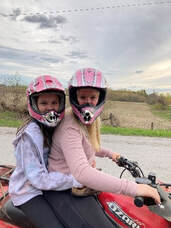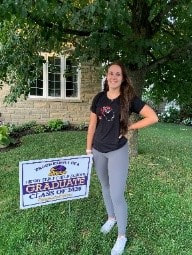Posts from the Team for Brain Injury Awareness Month
Garrett Bell - Co-Founder, Heads Up! Durham
Jennifer Hammond - March of Dimes
|
The sun is shining and summer is finally here! Emma and Kiera are happy to enjoy the great outdoors and ride the ATV around the farm. I’m Jennifer Hammond proudly representing March of Dimes on Heads Up! Durham and I would like to highlight Brain Injury Awareness Month. Please be safe and wear your helmets! For more info click below:
Jessica Head - 2020 recipient of the Heads Up! Durham ‘Rowan Stringer Commitment to Caring Scholarship’Rowan’s Law: Making the Game Safer
Remaining active, creating friendships, relieving stress and gaining life-long skills is just a small list of reasons why athletes engage in sport. Most importantly, youth will use the practical skills they gained from sport for the rest of their lives. In particular, rugby allows its players to develop teamwork through the synchronous drive of 8 players in a ‘scrum’. As well, respect is learned for the key players who make most of the decisions on the field. Although sport can be an exceptional outlet, and teach athletes physical and life skills, it can also have a significant life-changing impact through injury, especially brain injury. The sports community worldwide is beginning to recognize the seriousness of brain injury within sports, specifically physical contact sports like rugby. Concussions and other Traumatic Brain Injuries are not uncommon in the world of rugby. Players driving full force into one another, tackles that happen at lightning speed and players in ‘rucks’ that are essential in maintaining possession, all carry a risk of brain injury. In 2018, I went into a ‘ruck’ and collided heads with a player on the opposing team. The medical staff at the tournament diagnosed me immediately and I was placed under the concussion protocols. I was promptly taken out of the tournament, advised to rest, avoid strenuous activities for the following days, and was unable to play until I had clearance from a doctor. Concussion protocol ensures that the player will not make the brain injury more severe and helps avoid Second Impact Syndrome where the person suffers a second concussion before symptoms from an earlier concussion have subsided. Sadly, brain injuries within the world of sport were not always viewed with the same level of seriousness as they are today. Rowan Stringer is remembered as a talented, hard-working, and dedicated athlete. She was the caption of her high school rugby team and had been accepted to the University of Ottawa for Nursing. In 2013, Rowan sadly passed away from Second Impact Syndrome. After Rowan’s passing, Gord and Kathleen Stringer have been committed to making sports within Ontario and all around Canada safer for athletes. Rowan’s Law was passed in 2018 making concussion safety a priority within sport organizations. The dedicated work of Dr. Charles Tator, Professor of Neurosurgery and Canadian Concussion Centre Founder, as well as Eric Lindros, a former professional hockey player, and many more have made physical contact sports safer through the passing of Rowan’s Law. Most importantly, the dedication and passion of Gord and Kathleen Stringer helps ensure that what happened to their daughter, Rowan, will never happen to another athlete. We remember Rowan Stringer on Rowan’s Law Day, the last Wednesday of every September. Rowan will forever have an influence within the world of rugby and the sports community, making every athlete safer with three words: Hit. Stop. Sit. |
Colleen Worsely - Complex Injury Rehab
|
Bike Safety
Ladder Safety
|
My name is Sarah Ginn and I am a survivor of a very serious car crash in 2003. I was in the front passenger seat in a car when an oncoming vehicle crossed the centre line and hit mine head on. I was strapped in with a malfunctioning seat belt.
In the back seat behind me, my sister’s boyfriend wasn’t buckled up at all. The impact of the collision threw him into the back of my seat, crushing it down over top of me. The faulty seat belt unravelled and snapped, pitching me violently into the windshield.⠀⠀
⠀⠀⠀⠀⠀
I was airlifted to Sunnybrook Hospital’s trauma centre where I was only given a 10% chance of survival. My lungs collapsed, my liver was cut in half, and my brain was bleeding. I remained in a coma for six weeks, but miraculously regained consciousness.
I have limited recall of the first seven years of my recovery, which included 18 surgeries, speech and cognitive rehabilitation, and physical therapy. I moved forward with the love and support of my family and friends.
I’m a proud member of Heads Up! Durham’s P.A.R.T.Y. Committee (Prevent Alcohol and Risk related Trauma in Youth), a program that originated at Sunnybrook Hospital where I also volunteer.
Learn more about Sarah's second chance at:
https://www.durhamregion.com/news-story/4594644-sarah-s-second-chance/
In the back seat behind me, my sister’s boyfriend wasn’t buckled up at all. The impact of the collision threw him into the back of my seat, crushing it down over top of me. The faulty seat belt unravelled and snapped, pitching me violently into the windshield.⠀⠀
⠀⠀⠀⠀⠀
I was airlifted to Sunnybrook Hospital’s trauma centre where I was only given a 10% chance of survival. My lungs collapsed, my liver was cut in half, and my brain was bleeding. I remained in a coma for six weeks, but miraculously regained consciousness.
I have limited recall of the first seven years of my recovery, which included 18 surgeries, speech and cognitive rehabilitation, and physical therapy. I moved forward with the love and support of my family and friends.
I’m a proud member of Heads Up! Durham’s P.A.R.T.Y. Committee (Prevent Alcohol and Risk related Trauma in Youth), a program that originated at Sunnybrook Hospital where I also volunteer.
Learn more about Sarah's second chance at:
https://www.durhamregion.com/news-story/4594644-sarah-s-second-chance/
David Macdonald, CD, Community Representative
In honour of June being Brain Injury Awareness Month, we can help reduce brain injuries, especially among our children, by simply wearing a helmet while doing things like riding a bicycle or playing contact sports.
My name is David Macdonald and I hope this can be highlighted through my experience – during the war in Afghanistan.
I served in the Canadian Army for 15 years. I deployed to Afghanistan as part of Canada’s contribution to the rebuilding efforts and the war on terrorism. My role in the country was to provide security for supply convoys – basically drive (and walk) down roads to find the Improvised Explosive Device (I.E.D) bombs the Taliban liked to use before our trucks ran over them.
During a tour in 2009, I was in a serious vehicle accident crash while out on patrol. I was badly injured including a broken pelvis, leg, hand and neck. I also fractured my skull that resulted in a brain injury and a 14-day coma – the only thing that saved me that day was my helmet.
We always wore our helmets as part of our Full-Fighting Order (FFO). They were uncomfortable, hot and heavy. There was nothing better than pulling into a safe area and being able to take off your helmet. On the day of my injury, the helmet took the brunt of the force of my head hitting the armoured plating. Because of my helmet, I am alive today and have been able to fully recover. Without my helmet, I would not be able to write you this today and share my story on this Brain Injury Awareness Month.
Always remember to wear your helmet when it is needed. It will save your life!
My name is David Macdonald and I hope this can be highlighted through my experience – during the war in Afghanistan.
I served in the Canadian Army for 15 years. I deployed to Afghanistan as part of Canada’s contribution to the rebuilding efforts and the war on terrorism. My role in the country was to provide security for supply convoys – basically drive (and walk) down roads to find the Improvised Explosive Device (I.E.D) bombs the Taliban liked to use before our trucks ran over them.
During a tour in 2009, I was in a serious vehicle accident crash while out on patrol. I was badly injured including a broken pelvis, leg, hand and neck. I also fractured my skull that resulted in a brain injury and a 14-day coma – the only thing that saved me that day was my helmet.
We always wore our helmets as part of our Full-Fighting Order (FFO). They were uncomfortable, hot and heavy. There was nothing better than pulling into a safe area and being able to take off your helmet. On the day of my injury, the helmet took the brunt of the force of my head hitting the armoured plating. Because of my helmet, I am alive today and have been able to fully recover. Without my helmet, I would not be able to write you this today and share my story on this Brain Injury Awareness Month.
Always remember to wear your helmet when it is needed. It will save your life!
Members of the Durham Regional Police Service are actively educating motorists and enforcing the laws to keep our roadways safe. With our community partners, we can make our roadways safer for pedestrians, cyclists and motorists by implementing a broad strategy like Durham Vision Zero.
We are proud to be a member of Heads Up! Durham Steering Committee and the P.A.R.T.Y Program subcommittee to help educate youth in making more informed decisions, and about the tragic consequences often associated in risk-related activities.
We are proud to be a member of Heads Up! Durham Steering Committee and the P.A.R.T.Y Program subcommittee to help educate youth in making more informed decisions, and about the tragic consequences often associated in risk-related activities.

As Durham Regional Police Officers know, wearing a helmet is the single most effective way to reduce the risk of a Traumatic Brain Injury in a cycling crash. Proud partners of Heads Up! Durham.
Melissa Brabant - Ministry of Transportation, ATV Safety Week
|
We are pleased to announce the launch of our new animated videos for Off-Road Vehicles.
Our animated educational videos will be released during ATV Safety Week –June 7th- 13th. Throughout the week you will see new videos and clips for off-road and on-road riding. The full length videos are full of great information for all riders, such as; safety gear, training, appropriate machine size, and to know before you go. We can’t wait to share with you and encourage you to share too! So keep an eye out on the Ministry of Transportation’s Twitter and Facebook accounts. Our Ontario.ca/atv will also be updated next week to align with our new videos. And remember, always make your ride a safe ride. |









